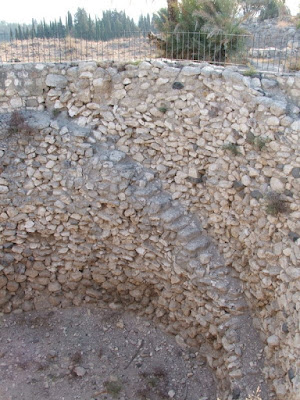
Ceasarea is a big site. Here, we are outside the back of the theater.

This statue must have been huge.
[to get an idea of the scale look at the previous picture]

When you enter the theater through the rear you can see the Mediterranean sea.

We came into the theater at the second ring level.
 Faith Lesson:
Faith Lesson:Our faith lesson was about the flesh-eater, or sarcophagus. These were used in the Hellenistic culture. First, a body was put in one of these; after the flesh was gone the bones were put into an ossuary. This was a called a "double burial".
When Jesus said "let the dead bury the dead". He was speaking out against the Hellenistic culture.


The translation of the stone seen above.
"Pontius Pilatus, the prefect of Judea, erected a building dedicated to the emperor Tiberius."
Pontius Pilate was a real person.

The remains of Herod the Great's glorious palace. The apostle Paul was imprisoned here.

The palace is to the left of this picture, the arena to the right, and the crusader city in front of you on the other side of the harbour.

The arena used for gladiator games. They think it was originally supposed to be for races, but it was too small. The larger arena was in a different place.
There is still much to be excavated yet in Caesarea.

On the way out we passed the crusader city. The
crusaders came to "liberate the Holy land". Instead, they left a path of destruction. It is a black page in our history.
Here you see the dry moat around the city. It is very European to make a moat
even though this is a dry climate.

































 These flowers smelled wonderful.
These flowers smelled wonderful.